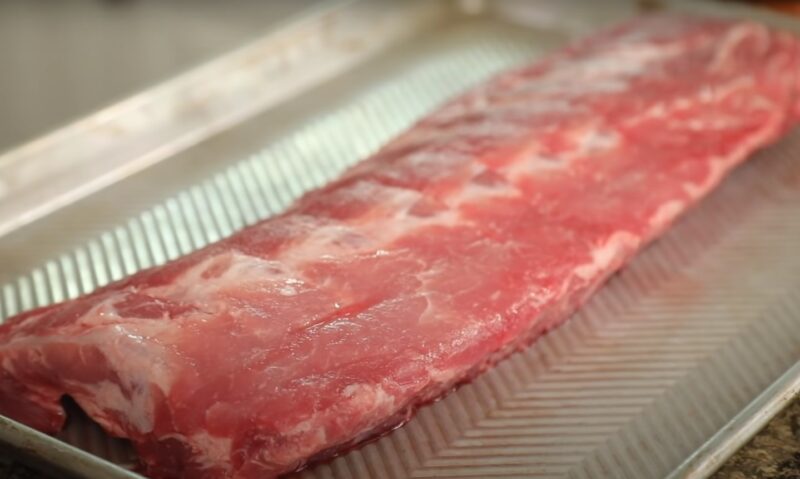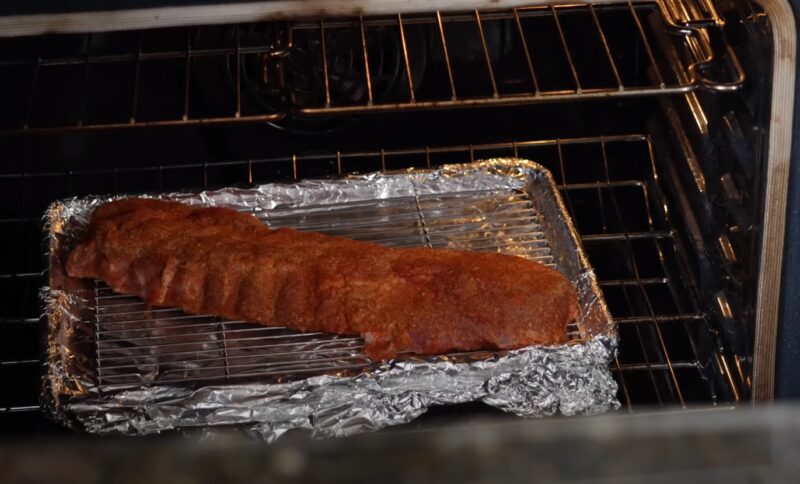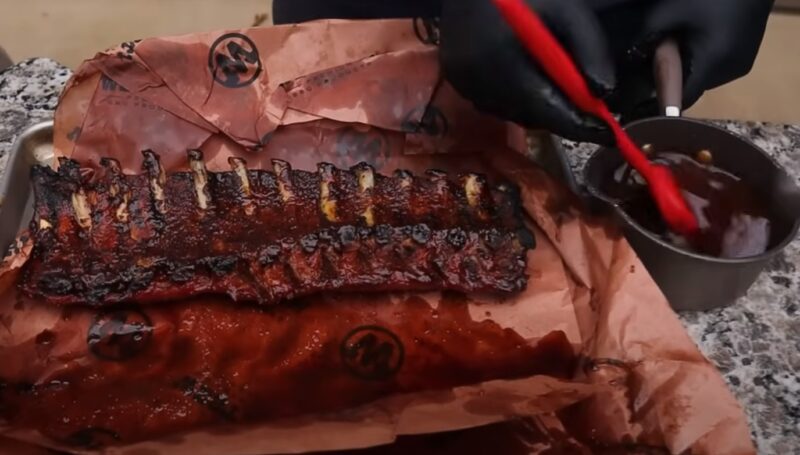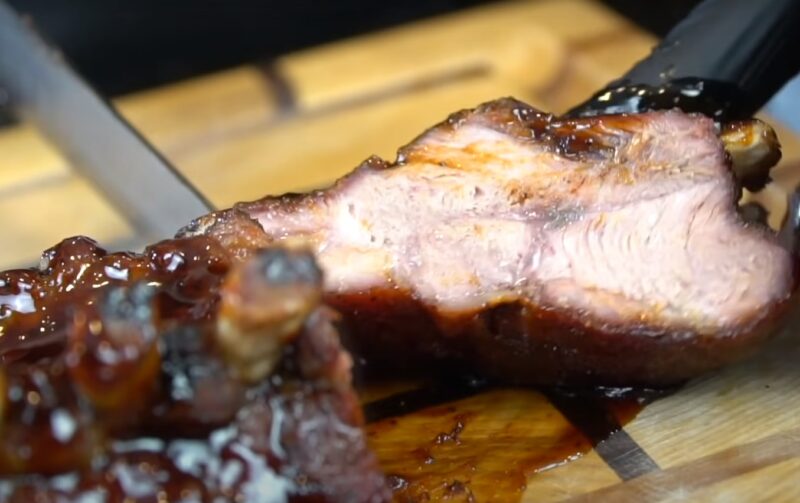When it comes to cooking ribs, one common question arises: should we place the ribs bone up or down? This might seem like a small detail, but it can significantly impact the flavor, texture, and overall quality of your ribs.
In this guide, we’ll explore the best practices for positioning them in a smoker, when wrapped, and in an oven. Our goal is to ensure that even beginners can achieve mouth-watering results every time.
Key Takeaways
Smoker – Bone Down

In a smoker, the most common recommendation is to cook ribs with the bone side down. This position allows the meat to get exposed to the smoker’s heat directly, leading to a smoky flavor and even cooking.
The bones act as a heat shield, protecting the meat from getting overcooked or burnt. Additionally, this orientation facilitates better smoke penetration, as the meaty side receives the full impact of the smoky environment, enhancing the flavor profile. It also simplifies the cooking process, as there’s no need for frequent turning or adjusting of the ribs.
For those planning to host a larger gathering, understanding the appropriate quantity of beef ribs to prepare is crucial, and you can find helpful guidelines on this topic here.
Benefits
- Even Cooking: Heat circulates over the meat evenly, ensuring that each part of the rib cooks at the same rate, preventing undercooked or tough spots.
- Smoke Flavor: Direct meat exposure to smoke maximizes flavor absorption, giving the ribs a deep, rich smokiness that’s highly sought after.
- Moisture Retention: Fat and juices drip naturally, basting the meat. This self-basting keeps the ribs moist and tender, preventing them from drying out during the long smoking process.
Exceptions
However, some pitmasters flip the ribs occasionally for even smoke and heat distribution. This method requires more attention but can lead to a more uniform bark (crust) and flavor.
Flipping can also prevent the bottom side from becoming too tough or charred, which is especially important in smokers with hot spots or uneven heat distribution. Some cooks believe that this occasional flipping helps in distributing the fat and juices more evenly, contributing to a more consistent texture.
In the Oven – Bone Down for Consistent Cooking

For oven cooking, placing ribs bone down is also advantageous. This method ensures that the heat surrounds the meat evenly, cooking it thoroughly without drying it out.
The bone-down position in the oven also mirrors the effect of a smoker, allowing the top side of the ribs to caramelize nicely while the bone side gets gently cooked by the radiating heat.
Benefits
- Heat Distribution: The oven’s consistent heat cooks the meat evenly, which is crucial for achieving that perfect tenderness without overcooking.
- Juiciness: The meat’s natural juices flow down, keeping it moist. This method ensures that the ribs remain succulent and full of flavor, as the juices act as a natural baste.
- Basting and Flipping: Some cooks prefer to baste and flip the ribs every 30 minutes to ensure all sides receive equal treatment. This process can enhance flavor and prevent drying but requires more effort. The act of basting adds an additional layer of flavor, and flipping ensures that each side gets an equal amount of heat and exposure to the oven’s environment.
When Wrapped – Bone Up

When wrapping ribs (often in foil), placing them bone up can be beneficial. This position allows the meat to sit in its juices, creating a steaming effect that tenderizes the ribs. The steam generated in this method is crucial for breaking down tough fibers in the meat, making it exceptionally tender and juicy.
Similarly, when preparing a brisket, ensuring it’s properly defrosted is crucial for maintaining moisture and flavor.
Benefits
- Tenderness: Steam softens the meat, making it fall off the bone tender. This cooking method is particularly effective for tougher rib cuts that benefit from prolonged, moist cooking.
- Flavor Infusion: Sauces and marinades interact directly with the meat. The position allows these flavors to seep into the meat more effectively, infusing the ribs with whatever spices or sauces are used in the cooking process.
- Consistency: By cooking ribs bone up when wrapped, the meat cooks more uniformly, preventing the bottom part of the ribs from becoming overcooked or burnt. This approach also ensures that the flavors and seasonings are evenly distributed throughout the meat.
Ribs Cooking Basics
The key factors in cooking ribs are temperature, time, and moisture.
| Cooking Method | Temperature Range | Cook Time | Moisture Source |
| Smoker | 225°F – 250°F | 4 – 6 hours | Wood smoke, wrapping |
| Oven | 275°F – 300°F | 2 – 4 hours | Basting, wrapping |
| Wrapped | Varies | Varies | Steam, sauce |
FAQs
Can I cook different types of ribs in the same manner?
Different types of ribs, like baby back, spare, and St. Louis style, have varying thicknesses and fat content, which can affect cooking time and method. Generally, baby back ribs cook faster than the thicker spare ribs. It’s important to adjust your cooking method and time based on the type of ribs you’re preparing.
How do I know when my ribs are perfectly cooked in a smoker?
The best way to check is the “bend test.” Use tongs to lift the ribs at one end; if they bend easily and the meat starts to crack on the surface, they’re likely done. Another method is checking if the meat has shrunk back from the bones by about half an inch.
Should I remove the membrane on the bone side of the ribs before cooking?
Yes, it’s generally recommended to remove the membrane. This tough layer can prevent flavors and smoke from penetrating the meat fully and can result in a less tender rib.
What’s the difference between dry rub and wet marinade for ribs, and does it affect how I should cook them?
Dry rubs are mixtures of dry spices and herbs applied directly to the meat before cooking, creating a flavorful crust. Wet marinades are liquid-based and typically used to tenderize and infuse the meat with flavor over time.
The choice between the two can influence the cooking method slightly; for example, wet marinades are better for low and slow cooking, whereas dry rubs can be suitable for higher heat and shorter cooking times.
Can I use a rib rack for cooking ribs in the oven?
Absolutely! A rib rack is a great tool for oven-cooking ribs. It allows you to cook multiple rib racks vertically, saving space and ensuring even air and heat circulation around the ribs.
Is it necessary to wrap ribs in foil when cooking in the oven?
Wrapping ribs in foil is not necessary, but it can help tenderize the meat by trapping moisture and heat. This method, known as the “Texas Crutch,” can also speed up the cooking process.
Summary
The debate of bone up or down when cooking ribs comes down to the cooking method and personal preference. In a smoker or oven, bone down generally leads to evenly cooked, flavorful, and juicy ribs. When wrapped, bone up can enhance tenderness and flavor infusion.
Experiment with both methods to discover your preferred style, and always remember that patience and attention to detail are key ingredients in cooking the perfect dish.
